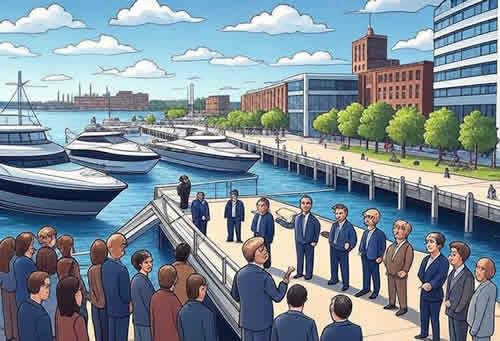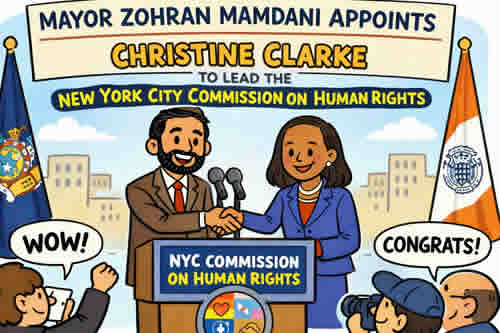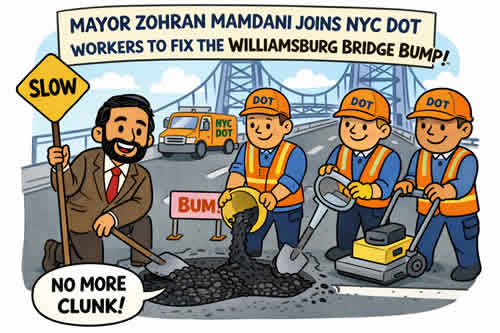New York City leaders, including Mayor Eric Adams and Governor Kathy Hochul, have announced the approval of a groundbreaking $3.5 billion plan to revitalize the Brooklyn Marine Terminal. This ambitious project will create a state-of-the-art, all-electric 60-acre maritime port, 6,000 new homes with 40% affordable units, 28 acres of open public space, and over 275,000 square feet of industrial and commercial space. Expected to generate $18 billion in economic impact and create nearly 40,000 jobs, the plan prioritizes sustainable development, community engagement, and resilience against climate change. As part of the city’s “Harbor of the Future” initiative, this transformation will modernize New York’s waterfront, foster green jobs, and boost economic growth across Brooklyn and the entire city.
Mayor Adams, Governor Hochul, Representative Goldman, Senator Gounardes Announce Passage of Historic $3.5 Billion Vision Plan to Transform Brooklyn Marine Terminal Into Modern Maritime Port, Create New, Vibrant Mixed-Use Community Along Waterfront

– New York City Mayor Eric Adams, New York Governor Kathy Hochul, New York City Economic Development Corporation (NYCEDC) President and CEO Andrew Kimball, U.S. Representative Dan Goldman, and New York State Senator Andrew Gounardes today announced that the Brooklyn Marine Terminal (BMT) Task Force has passed a historic vision plan to turn BMT into a modern, maritime port and create a vibrant, mixed-use community along the Brooklyn waterfront. The proposal — which is backed by $418 million in city, state, and federal investments — will transform the dilapidated marine terminal into a 60-acre, all-electric maritime port that can, once again, serve as a key economic driver for the community and city. In addition to a revitalized port, the plan passed today will also create 6,000 new homes — including over 2,400 permanently-affordable units — as well as at least 28 acres of public space, 275,000 square feet of commercial space, 250,000 square feet of community facility space, and 275,000 square feet of light-industrial and industrial space at discounted rents. The plan, which covers a total of 122 acres, will also deliver vital resiliency and infrastructure upgrades for the area while generating an estimated $18 billion in economic impact, 37,000 temporary construction jobs, and 2,000 permanent jobs. The Vision Plan adopted by the BMT Task Force serves as the foundation for all future investments and redevelopment at BMT.
After assuming control of BMT in May 2024, the Adams administration convened a BMT Task Force to lead an extensive community engagement process and develop a shared vision for the site. Following a year of engagement with over 4,200 community members, today’s landmark vote continues Mayor Adams’ vision to turn New York City’s waterfront into a “Harbor of the Future;” establish New York City as the global destination for green technology, innovation, and opportunity; and create approximately 53,000 temporary and permanent jobs and $95 billion in economic impact.
“Today, our city took a massive step towards the future. By approving this $3.5 billion vision plan, we will turn a crumbling marine terminal into a modern maritime port while creating thousands of affordable homes and tens of thousands of good-paying jobs. We’ll deliver the open space our city needs and keep New York at the front of the green economy,” said Mayor Adams. “For years, naysayers have told us that the days of big ideas and bold initiatives were over, but New York City is proving them wrong. We’re turning our waterfront into a ‘Harbor of the Future’ and unlocking opportunity for generations to come. When I came into office, I promised to ‘Get Stuff Done,’ and, today, we are doing it in a big way. Thank you to all the members of the BMT Task Force who took their responsibility seriously and to all the community members and experts who weighed in along the way.”
“This bold, $3.5 billion vision will transform the Brooklyn Marine Terminal into a modern, all-electric maritime hub and a thriving new neighborhood — delivering good-paying jobs, affordable homes, and public amenities for generations to come,” said Governor Hochul. “New York state is proud to stand with the city to make this once-in-a-generation investment in our waterfront, our economy, and our communities. Together, we’re proving that growth, resiliency, and equity can go hand in hand.”
“Today is a historic day for New York City. The Brooklyn Marine Terminal Task Force, which is comprised of city, state, and federal elected officials, and representatives ranging from local neighborhoods to regional agencies, voted to advance the $3.5 billion vision-plan to create a modern, all-electric 60-acre port and mixed-use community with 6,000 units of housing in the heart of the ‘Harbor of the Future,’” said Deputy Mayor for Housing, Economic Development, and Workforce Adolfo Carrion, Jr. “I appreciate and thank all BMT Task Force members for their hard work on the planning process over the past year and look forward to the first ribbon cutting on the BMT site in just a few short years.”
“The passing of the Brooklyn Marine Terminal Vision Plan is a historic, transformative investment in New York City’s economic future — unlocking thousands of jobs, modernizing critical infrastructure, and creating a resilient, mixed-use waterfront that drives inclusive growth,” said NYCEDC President and CEO Kimball. “This plan positions the city as a national leader in maritime innovation with a critical node in the city’s Blue Highways network that will get trucks off our streets, while delivering lasting benefits to the Red Hook community and beyond. I would like to extend my deepest gratitude to the entire task force for their steadfast commitment to working with NYCEDC to create this monumental vision.”
“For the first time in two generations, the Brooklyn Marine Terminal is on track to once again become a vital and vibrant economic, maritime, environmental, and community asset,” said U.S. Representative Goldman. “For decades, the port and surrounding area was allowed to fall into disrepair, and every attempt to revitalize it failed. Today, we have taken a truly historic step forward in finally realizing a plan that will save, modernize and expand the port, create an industrial and commercial hub for the future, address climate change and spearhead the blue highway, connect our neighborhoods to the waterfront, and build thousands of affordable homes to tackle the housing crisis. I am grateful for the time, energy and effort spent by all Task Force members, regardless of how they voted, and I am grateful that this community-centered project was able to achieve so much for so many. I look forward to continuing to work with my colleagues, the city, state and EDC to build a brighter future for the Brooklyn waterfront.”
“For decades, the Brooklyn Marine Terminal has been allowed to decay and become a barrier between our communities and the waterfront,” said State Senator Gounardes. “Now, we have a unique chance to transform the terminal into something that actually meets our needs: a mixed-use neighborhood with a modernized port, new parks, industrial and community space, and thousands of new affordable homes. This is a complex project with a lot of different stakeholders, and this vision plan reflects the many good ideas and difficult decisions generated by the Task Force process. If we’re serious about creating a city that works for all of us, we need to actually get things done. This plan is an important step in doing just that.”
The BMT Vision Plan will transform a crumbling marine terminal into a modern, all-electric port while creating thousands of homes and tens of thousands of new jobs.
The BMT Task Force — which is chaired by U.S. Representative Dan Goldman and co-chaired by New York State Senator Andrew Gounardes and New York City Councilmember Alexa Avilés — is comprised of wide range of experts, including federal, state, and local elected officials, the local community board, local resident organizations, maritime and industrial stakeholders, unions, planning and environmental justice organizations, and representatives of the local business community. The BMT Task Force voted in favor of a Vision Plan that creates a high-level framework in nine distinct areas:
- Port: Under the plan, the BMT will be transformed into a 60-acre modern and sustainable all-electric port with a new marginal pier to promote water-to-water freight, remove trucks from local streets and New York City roadways, and serve as a key node in the Adams administration’s Blue Highways initiative to move more goods along the city’s waterways.
- Affordable Housing: The plan will deliver 6,000 housing units on the site, with 40 percent, or 2,400 units, permanently affordable at an average of 60 percent of the Area Medium Income. A total of 200 affordable units will be reserved on-site for New York City Housing Authority (NYCHA) Red Hook Houses East and West residents, and 50 affordable units will be reserved for NYCHA Wyckoff and Gowanus Houses residents. Additionally, a $75 million fund to preserve or create affordable units off-site in Community Board 6 will be created, and $200 million will be allocated to NYCHA Red Hook Houses East and West.
- Atlantic Basin: The Brooklyn Cruise Terminal will also be redeveloped with new public open space, industrial and commercial space, and up to a 400-key hotel, transforming the area around Pier 11 and Pier 12 into an attractive waterfront destination district open to the community.
- Industrial: The plan will create over 275,000 square feet of industrial space available at discounted rents, more than 275,000 square feet of commercial space across the site to enliven and support community retail corridors, and a $10 million development fund to support the industrial sector within the broader Red Hook neighborhood.
- Education and Workforce: The plan promotes a comprehensive workforce strategy, including a Project Labor Agreement; targeted community hiring; a dedicated world-class experiential learning center at Pier 11; and funding to establish an economic mobility network in Red Hook and a maritime career readiness program for residents of NYCHA Red Hook Houses East and Red Hook Houses West. Over 250,000 square feet of community facilities and cultural space, including space for a new public school at BMT North will also be included.
- Open Space: The vision plan includes at least 28 acres of public open space and approximately one mile of new public waterfront access and greenway.
- Resiliency: The plan calls for a comprehensive resiliency strategy, including a raised site to protect against future sea level rise, a floodwall designed to withstand a 2,100, 100-year storm, and on-site stormwater management.
- Connectivity and Transit: The plan puts pedestrians and public transit first, prioritizing pedestrian mobility while also improving bus speeds to rider destinations and reducing truck traffic. It will include pedestrianized streets, no parking minimums, district-wide garages, micromobility and freight hubs, bus priority lanes, increased ferry services, and a $50 million commitment for electric shuttle service as a bridge towards the Metropolitan Transportation Authority evaluating the restoration of historic bus service such as the B71, or establishing enhanced and/or new bus service for improved intra and inter-neighborhood mobility.
- Governance and Implementation: The plan will create a new legal entity — the Brooklyn Marine Terminal Development Corporation (BMTDC) — to realize the vision plan, ensure development is financially viable and self-sustaining, and implement a phased redevelopment delivering community benefits in partnership with the mixed-use development. The board of the BMTDC will include appointees of the mayor, governor, and local elected officials, as well as representation from the local community, such as NYCHA Red Hook East and West, as well as maritime and industrial expertise.
In the coming weeks, NYCEDC will form a Brooklyn Marine Terminal Advisory Task Force to guide the project through environmental review and development of a General Project Plan. NYCEDC will continue engaging with this new task force to refine the specifics of the site plan, ultimately leading up to NYCEDC’s release of a draft Environmental Impact Statement and Empire State Development’s adoption of a draft General Project Plan in 2026.
NYCEDC will also launch a Request for Expressions of Interest (RFEI) in the coming weeks to solicit proposals from port operators, developers, and maritime industry experts on how to optimize maritime operations at BMT. As part of this RFEI, NYCEDC will seek input on optimal size, layout, and economically viable uses of the commercial port, including Blue Highways connections to Hunts Point. NYCEDC is aiming to release the first request for proposal for a long-term port operator by the end of 2026.
The plan passed today represents a wide range of community and stakeholder input. Over the past year, NYCEDC has engaged over 4,260 community members, received 915 survey responses, and held 47 public engagements, including 27 workshops, 15 feedback and info sessions, three town halls, and two surveys. Additionally, NYCEDC conducted 11 site tours with 198 members of the public, NYCHA residents, elected officials, and city agencies; 23 advisory group meetings; 32 task force meetings, office hours, and small group discussions; 13 stakeholder focus groups and project briefings with small businesses, community associations, and organizations; nine NYCHA Red Hook Houses East and West tabling events, focus groups, and feedback sessions; and five canvassing efforts in Red Hook with Green City Force. This vision plan incorporates feedback heard across each of these sessions and delivers commitments addressing key themes heard from the community, such as a need for a modern and sustainable port and container operations, expanded waterfront open space, creation of workforce training and career pipelines, increased public transit, and resiliency protections from climate change.
The Adams administration is already delivering on its commitment to modernize and electrify the port. In March, NYCEDC announced an $18 million investment and the execution of three contracts to upgrade the port, including the removal of four out-of-service cranes across Piers 9A and 10, the purchase of a new electric ship to shore crane to serve the Red Hook Container Terminal at Pier 10, and crucial fender repairs to Pier 10 to protect the pier from future vessel damage. To date, NYCEDC has secured nearly $418 million in public capital to rebuild and modernize the port; this includes an early $80 million city capital commitment, $65 million in state funding, a $164 million grant from the U.S. Department of Transportation — the largest ever received by NYCEDC — and a corresponding $109 million city capital match.
Today’s announcement also marks major progress toward realizing NYCEDC’s “Blueprint for Blue Highways” released earlier this month, which provides a strategy to create up to 8,000 new jobs by moving freight by waterways instead of roadways, for a total of 117,000 jobs across Blue Highways sectors by 2035. The Adams administration’s Blue Highways initiative works to reduce truck traffic and increase freight capacity across the five boroughs by shifting the movement of more goods onto the city’s waterways. More progress has been made on Blue Highways in the last two years than in the 20 previous, including prior announcements of a new Hunts Point Marine Terminal and a micro-freight facility at Downtown Skyport.
Today’s vote marks a major step forward in the Adams administration’s efforts to build the Harbor of the Future — a reimagined network of innovation and growth across New York City’s waterways. In addition to a modern maritime port and vibrant mixed-use community hub at BMT in Red Hook, the Harbor of the Future includes emerging innovation centers such as the Hunts Point Produce Market in the Bronx; the newly-announced climate innovation hub “BATWorks” at the Brooklyn Army Terminal in Sunset Park; the country’s largest offshore wind port at the South Brooklyn Marine Terminal; the Science Park and Research Campus in Kips Bay in Manhattan; new sustainable housing and public space on the North Shore of Staten Island; and an anchor research and educational partnership with the New York Climate Exchange on Governors Island. Additionally, today’s announcement fulfills a key commitment in Mayor Adams’ “Green Economy Action Plan,” a first-of-its-kind plan that lays out a roadmap to growing the city’s green economy, invests in jobs and sectors that help the city combat climate change, and positions New Yorkers to benefit from the nearly 400,000 projected ‘green-collar’ jobs in New York City by 2040.
September 22, 2025 NEW YORK
Sources: NYC.gov , TV503com
Big New York news BigNY.com – Midtown Tribune news









